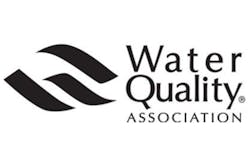1. As used in membrane water treatment, the term "flux" means:
a. a state of continuous change
b. a substance used to promote fusion
c. amount or percent of total dissolved solids (TDS) rejection
d. gallons per square foot per day (GFD)
2. Flux of ultrafilter membranes is (a or b) than the flux of reverse osmosis membranes.
a. higher
b. lower
3. Recovery in membrane filtration means:
a. an economic upturn
b. to restore a fouled membrane by cleaning
c. a comparison of product water flow to feedwater flow
d. the quantity of solids retained by the membrane
4. Membrane filter retention is:
a. the minimum particle size that is separated out
b. the length of time water is in contact with the membrane
c. the length of time water is held in the storage tank
5. The more appropriate treatment to remove colloidal silica from a water supply is:
a. ion exchange
b. reverse osmosis (RO)
c. ultrafiltration (UF)
6. Precursor compounds that react with chlorine to form trihalomethanes (THMs) are more easily filtered from water than are the THMs themselves. (True or False)
7. Long chain polymers, casting, quenching and drying are all terms involved with:
a. boiler water treatment
b. high purity water recirculation loops
c. RO and ultrafilter membrane manufacturing
8. Asymmetric ultrafilter membranes are more susceptible to particle pore plugging than are the microporous membranes. (True or False)
9. The highest packing density for membrane surface area can be obtained with the following membrane construction:
a. hollow fiber
b. plate and frame
c. tubular
d. spiral-wound
10. Diffusion netting and porous matting are necessary construction components for which membrane assembly configuration:
a. hollow fiber
b. plate and frame
c. tubular
d. spiral-wound
